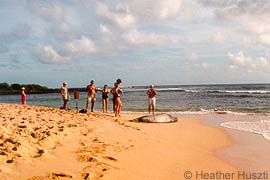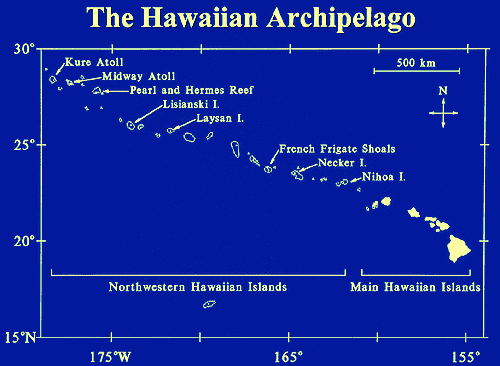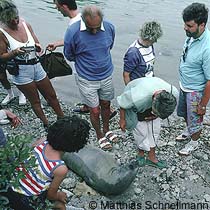 |
|
|
 |
||
I became interested in the monk seal while in Kauai, Hawaii. While there in November, we had 14 seal sightings in 6 days around the Poipu Beach area. We saw up to 4 different seals on one day. We were wondering if this was an unusual occurrence? I took a bunch of pictures, hoping some would turn out. Unfortunately I did not get any pictures of the one monk seal we saw playing, rather actively, with one of the warning signs in the sand. He (or she?) went right for the sign, dug his nose into the sand right below it and then raised his head, uprooting the sign. He then continued to toss the sign about with his head for at least 10 minutes (the time we were watching). Since all of the other times we saw them they were generally just sleeping, we were pretty amazed watching this playful activity. The Hawaiian monk seal is highly endangered and is found only within the Hawaiian Archipelago. Nearly all monk seals are at six main reproductive sites in the Northwestern Hawaiian Islands (French Frigate Shoals, Laysan Island, Lisianski Island, Pearl and Hermes Reef, Midway Atoll, and Kure Atoll). Current abundance is approximately 1,300 to 1,400 animals. The total number of seals has declined 60% since the late 1950s, and 4% to 5% annually from 1985 to 1993. Counts have remained essentially unchanged since 1993, but may decline further in the near future because of poor juvenile survival rates, and the resulting low number of young females reaching reproductive age at French Frigate Shoals, the most populous breeding location. Because the stability of a metapopulation may increase with additional population units, a healthy subpopulation in the main Hawaiian Islands could promote the long-term existence of monk seals. A relatively small number of monk seals are distributed throughout the main Hawaiian Islands. They are highly dispersed, and have been sighted at all the islands, including Niihau and Kahoolawe. Pupping has been recorded on Kauai, Oahu, Molokai, and Maui. An unknown number of seals are naturally found in the main islands. In addition, 21 adult male seals were taken from Laysan Island and released around the main islands in 1994 by the National Marine Fisheries Service (NMFS) in order to balance the sex ratio of the Laysan Island population, where an excess of aggressive males was causing high female mortality. The November 1999 issue of The Monachus Guardian delivered a few home truths that the leisure, travel and tourism industry will not like to face up to. The image they want to project is one of unspoilt landscapes, romantic sunsets, sun and sea drenched relaxation – not death and destruction. Yet Monachus has been brought to extinction's door in one Mediterranean country after another. Even in today's allegedly more ecologically enlightened times, the mass tourism industry continues to chase its billion dollar profits, with no conscience, no care, no help for such a shy, beautiful animal that must now hide away from all the noise, vulgarity and pollution – places that are increasingly few and far between. What I don't understand is this. Tourism's responsibility for the decline and extinction of the species has been established without a shadow of a doubt. As Sadruddin Aga Khan points out in his editorial, grassroots conservation organizations are actually underwriting this mega-profit, mega-arrogant industry by tackling the environmental problems it is causing. Can’t the industry be dragged into court, and sued for damages? At least there might finally be some justice for the monk seal! Re. Mass Tourism & the Mediterranean Monk Seal Why not draw up a list of tourist companies most to blame for eradicating the [Mediterranean] monk seal? You point to hotels being built over seal caves and tour boats deliberately searching out the animals... Why not begin listing names so that we as customers can vote with our feet? It is absolutely outrageous that an industry should be getting away with something that is actually even worse than murder – the extinction of an entire species. Re. The Old Woman Who Swallowed the Fly A quick note to set the record straight. In The Monachus Guardian Vol. 2, No. 1 you mention "The Old Woman Who Swallowed a Fly" as being an English nursery rhyme. Allen Mills, Canadian folk singer from Montreal, wrote the song back in the 1950s in Montreal. Thank you for sending me a copy of your excellent Monachus Guardian. The magazine is wonderful (the web site too) and I hope that it will contribute to exchanging experiences on monk seal conservation. Re. Has Anyone Seen a Caribbean Monk Seal? and Caribbean Monk Seals – Are they Extinct?
Sightings on the Main Hawaiian Islands

Heather Huszti, USA ![]() Thea Johanos, Wildlife Biologist at the NMFS Honolulu Laboratory replies:
Thea Johanos, Wildlife Biologist at the NMFS Honolulu Laboratory replies:
The Hawaiian monk seal actually has a metapopulation (a population composed of several relatively discrete subpopulations). Although some seals travel between breeding areas, most monk seals remain where they are born for their entire lives. Having a metapopulation may lower the risk of extinction for monk seals because local population trends are independent (i.e., the subpopulations don’t all increase or decrease at once), and local populations that have declined can be bolstered by immigration from other areas. For example, while the population at French Frigate Shoals has recently declined, numbers at Pearl and Hermes Reef, Kure Atoll, and Midway Atoll have increased. Also, much of the present population recovery at Midway Atoll is because of immigration of seals from nearby atolls.
Reported sightings of monk seals in the main islands are sporadic and must be highly biased towards seals that frequent populated areas. Although these reports are valuable, we cannot infer abundance trends from them. Monk seals are vulnerable to human disturbance, especially when nursing pups, and avoid pupping and hauling out to rest where disturbance is high. Thus, it is likely that additional births and seal haulouts occur in remote areas and go unreported. This year, we plan to conduct our first complete aerial survey of all main Hawaiian Islands in order to estimate the minimum number of seals using these islands and to characterize their habitat use. Previously, in 1998, eight seals were counted during a single aerial survey of Kauai as part of an oil spill response. Monk seals in the main Hawaiian Islands are much more vulnerable to human-caused harm given the proximity to large numbers of people, nearshore fisheries, marine industry/commerce, and boat traffic. In the event of an oil spill, it would be invaluable to possess baseline data on population size and whether affected areas are known monk seal habitat.
You are fortunate to have seen Hawaiian monk seals in the wild. Although most people in Hawaii have never seen a monk seal, reported seal sightings have increased in the main Hawaiian Islands, particularly on Kauai. On Kauai’s south shore, near Poipu Beach, monk seals are seen almost daily in the winter months, and several of them may haul out at a time. For example, this past fall at least five seals went through their annual molt (a process which takes several weeks) in the vicinity of Poipu. The number of reported pups born in the main Hawaiian Islands has also clearly increased; a total of 18 seal births have been reported since 1962 in the main islands, 12 of which have occurred since 1996. At least three pups were born in the main islands last season, one each on Kauai, Molokai, and Maui. Sadly, the Kauai pup died shortly after weaning because of trauma, possibly incurred in a collision with a boat.
Because of the increased presence of monk seals, State and Federal agencies, environmental groups, and members of the community have joined in a cooperative effort to protect and enhance the monk seal population in the main Hawaiian Islands. The Monk Seal Watch Program combines management and monitoring, community participation, environmental education, and cultural awareness. Volunteers identify and document resting seals, place warning/education signs strategically around seals resting on the beach (particularly at high-use beach parks in order to eliminate or minimize human disturbance), and provide environmental education to beach users.
You can help protect the Hawaiian monk seal by preventing disturbance to them and reporting seal sightings and/or seal harassments by calling the monk seal hotline at (808) 983-5715. State and Federal laws prohibit harassment of these animals. To prevent disturbance, view seals from a distance and remain out of sight if possible. Keep at least 100 feet away, more if encountering a mother and pup. These endangered seals feed offshore, often at night, and uninterrupted rest on land is critical for their survival. Furthermore, seals are wild and may bite if disturbed. Contact with humans or dogs may transmit diseases and an epidemic could cause the seal’s extinction. Although monk seals may approach people, you should always move away to avoid interaction, and keep dogs away from seals.
Thank you for your interest in Hawaiian monk seals, and for sharing your observations with us.
Thea Johanos
Wildlife Biologist, Protected Species Investigation, NMFS Honolulu Laboratory
Web: www.nmfs.hawaii.edu/psi/home.htm
J. J. Wilcox
![]() Editor’s reply: We appreciate the sentiment. Although the prospects look bleak – as in most cases where powerful industrial interests are stacked against a vulnerable species or habitat – The Monachus Guardian is taking legal advice. We will report our findings in the November issue.
Editor’s reply: We appreciate the sentiment. Although the prospects look bleak – as in most cases where powerful industrial interests are stacked against a vulnerable species or habitat – The Monachus Guardian is taking legal advice. We will report our findings in the November issue.
Dynamite, Seals and the Dilek Peninsula National Park
There is yet another example of development interests invading monk seal habitat and monk seal protected areas.
In January 1997, we received a letter from a diving instructor from Aydin, who informed us that he had photographed a monk seal on the southern coasts of Dilek Peninsula National Park. Both the seal and the Dilek coastline were clearly identifiable in the pictures he sent us.
At the same time, the diver also alerted us that a road was being cut through the National Park from the south, causing serious damage. He reported that, while in his car on the road, he himself observed stones falling near the monk seal swimming nearby, and that he saw the seal fleeing the area because of the dynamite blasting!
As indicated in your November 99 article on tourism’s impact on the monk seal (Mass Tourism and the Mediterranean Monk Seal), the northern zone of the Dilek National Park is already swarming with tourists during the summer period. It was our concern that the new road being built from the south would cut through the Peninsula linking up with the north, thereby increasing tourism dramatically in monk seal habitat.
We received no reply to our initial complaint to the authorities. Then on 2 May 1997 I visited the area and saw for myself how the Ministry of Forestry (MoF) had opened up a brand new road extending from Karina to Dip Burun along on the southern shore of the Peninsula.
We then compiled as much information as we could and submitted it to the relevant authorities with a formal complaint. It was our contention that the development was in violation of the Bern and Barcelona Conventions, particularly their stipulation that the habitats of endangered species must be protected.
In a letter to the Forestry General Directorate (copied to SAD-AFAG), the National Parks General Directorate (NPGD) requested an explanation for the construction, and asked for it to be halted because of the importance of the region’s wildlife. In their reply, the Forestry General Directorate declared that the road had been opened up only to salvage forest products after a fire. They also assured the NPGD that the road would not be used for any other purpose and that it would remain strictly closed to visitors.
While there is reason to believe that the authorities will live up to their promises, the events related above indicate how easy it is for sensitive monk seal habitat to be threatened and destroyed. It seems that our vigilance is necessary all of the time – even in protected areas.
Cem O. Kiraç, SAD-AFAG, Ankara.
Vote With Your Feet
Susan Streitfeld, USA.
English Nursery Rhyme?
W. Hoek, the Netherlands.
Sea Otters and Seals
Our society is the largest Bulgarian conservation NGO. We have branches in all big Bulgarian cities along the Black Sea. Unfortunately the monk seal was exterminated in Bulgaria a few years ago, but we hope that it will be reintroduced in the future...
I have some remarks about the sightings of monk seals around Italy [The Monachus Guardian Vol. 2 No. 1, May 1999]. Are there otters there? During our investigations on monk seals in Bulgaria, we found that there is a sea population of otters. Unfortunately, some fishermen very often confuse the otter with the seal...
Stefan Avramov
Bulgarian Society for the Protection of Birds / BirdLife Bulgaria
Caribbean Seal No More
Just a brief comment on the Ian Boyd report on "circumstantial" evidence [for the continued existence of the Caribbean monk seal, Monachus tropicalis, TMG 1(2): December 1998]. Local fishermen are often quite eager to please inquiring people with what they want to hear. It is also a fact that Hooded Seals (Cystophora cristata) and Harp Seals (Phoca groenlandica) and also Harbour Seals (Phoca vitulina) can often be found off course, e.g. the Azores, Florida, etc. Let’s not beat a dead horse. Circumstantial evidence is not evidence. I'm afraid the Caribbean monk seal is no more.
W. Hoek, the Netherlands.
The editor reserves the right to edit letters for the sake of clarity and space
Copyright © 2000 The Monachus Guardian. All Rights Reserved